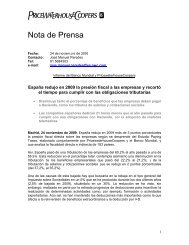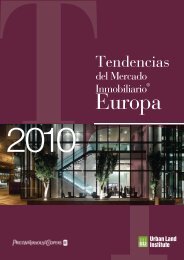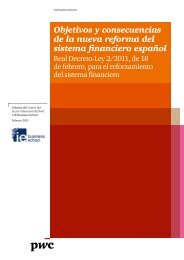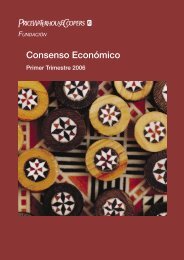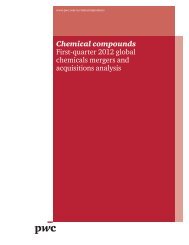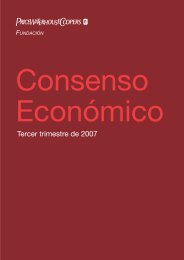- Page 1:
Nº 40 Los contenidos de esta publi
- Page 4 and 5:
Análisis de los desarrollos normat
- Page 6 and 7:
Análisis de los desarrollos normat
- Page 8 and 9:
ÍNDICE Págs. Prólogo ...........
- Page 10 and 11:
PRÓLOGO La aprobación de la Ley 3
- Page 12:
Prólogo ficación, sino antes al c
- Page 15 and 16:
Análisis de los desarrollos normat
- Page 17 and 18:
Análisis de los desarrollos normat
- Page 19 and 20:
Análisis de los desarrollos normat
- Page 21 and 22:
Análisis de los desarrollos normat
- Page 23 and 24:
Análisis de los desarrollos normat
- Page 25 and 26:
Análisis de los desarrollos normat
- Page 27 and 28:
Análisis de los desarrollos normat
- Page 29 and 30:
Análisis de los desarrollos normat
- Page 31 and 32:
Análisis de los desarrollos normat
- Page 33 and 34:
Análisis de los desarrollos normat
- Page 35 and 36:
Análisis de los desarrollos normat
- Page 37 and 38:
Análisis de los desarrollos normat
- Page 39 and 40:
Análisis de los desarrollos normat
- Page 41 and 42:
Análisis de los desarrollos normat
- Page 44 and 45:
II. ANTECEDENTES NORMATIVOS 2.1. RE
- Page 46 and 47:
Antecedentes normativos Por lo tant
- Page 48 and 49:
Antecedentes normativos o recibir,
- Page 50 and 51:
Antecedentes normativos • Depende
- Page 52 and 53:
Antecedentes normativos 3. Promover
- Page 54 and 55:
Antecedentes normativos • Estable
- Page 56 and 57:
Antecedentes normativos entorno fam
- Page 58 and 59:
Antecedentes normativos e. El servi
- Page 60 and 61:
Antecedentes normativos ción espec
- Page 62 and 63:
Antecedentes normativos b. Salud (a
- Page 64 and 65:
III. RÉGIMEN JURÍDICO VIGENTE En
- Page 66 and 67:
Régimen jurídico vigente solicita
- Page 68 and 69:
Régimen jurídico vigente f) En es
- Page 70 and 71:
Régimen jurídico vigente febrero,
- Page 72 and 73:
Régimen jurídico vigente En relac
- Page 74 and 75:
Régimen jurídico vigente No obsta
- Page 76 and 77:
Régimen jurídico vigente cluyen e
- Page 78 and 79:
Régimen jurídico vigente B. Asimi
- Page 80 and 81:
Régimen jurídico vigente de 2007)
- Page 82 and 83:
Régimen jurídico vigente sino a o
- Page 84 and 85:
Régimen jurídico vigente • Resp
- Page 86 and 87:
Régimen jurídico vigente mente cu
- Page 88 and 89:
Régimen jurídico vigente En este
- Page 90 and 91:
Régimen jurídico vigente ADMINIST
- Page 92 and 93: Régimen jurídico vigente ADMINIST
- Page 94 and 95: Régimen jurídico vigente 3.3. PRO
- Page 96 and 97: Régimen jurídico vigente cias o d
- Page 98 and 99: Régimen jurídico vigente El PIA s
- Page 100 and 101: Régimen jurídico vigente ral exis
- Page 102 and 103: Régimen jurídico vigente Todo ell
- Page 104 and 105: Régimen jurídico vigente la Admin
- Page 106 and 107: Régimen jurídico vigente Por el c
- Page 108 and 109: Régimen jurídico vigente 3.4.2. D
- Page 110 and 111: Régimen jurídico vigente Decreto
- Page 112 and 113: Régimen jurídico vigente ADMINIST
- Page 114 and 115: Régimen jurídico vigente rrespond
- Page 116 and 117: Régimen jurídico vigente Como res
- Page 118 and 119: Régimen jurídico vigente 3.5. RET
- Page 120 and 121: Régimen jurídico vigente Diversas
- Page 122 and 123: Régimen jurídico vigente ADMINIST
- Page 124 and 125: Régimen jurídico vigente 3.5.3. C
- Page 126 and 127: Régimen jurídico vigente • La c
- Page 128 and 129: Régimen jurídico vigente El perio
- Page 130 and 131: Régimen jurídico vigente ferior a
- Page 132 and 133: Régimen jurídico vigente A pesar
- Page 134 and 135: Régimen jurídico vigente Grado II
- Page 136 and 137: Régimen jurídico vigente • Cuan
- Page 138 and 139: Régimen jurídico vigente pleado p
- Page 140 and 141: Régimen jurídico vigente puedan p
- Page 144 and 145: Régimen jurídico vigente — El C
- Page 146 and 147: Régimen jurídico vigente cales de
- Page 148 and 149: Régimen jurídico vigente — Cono
- Page 150 and 151: IV. SERVICIOS Y PRESTACIONES ECONÓ
- Page 152 and 153: Servicios y prestaciones económica
- Page 154 and 155: Servicios y prestaciones económica
- Page 156 and 157: Servicios y prestaciones económica
- Page 158 and 159: Servicios y prestaciones económica
- Page 160 and 161: Servicios y prestaciones económica
- Page 162 and 163: Servicios y prestaciones económica
- Page 164 and 165: Servicios y prestaciones económica
- Page 166 and 167: Servicios y prestaciones económica
- Page 168 and 169: Servicios y prestaciones económica
- Page 170 and 171: Servicios y prestaciones económica
- Page 172 and 173: Servicios y prestaciones económica
- Page 174 and 175: Servicios y prestaciones económica
- Page 176 and 177: Servicios y prestaciones económica
- Page 178 and 179: Servicios y prestaciones económica
- Page 180 and 181: Servicios y prestaciones económica
- Page 182 and 183: Servicios y prestaciones económica
- Page 184 and 185: Servicios y prestaciones económica
- Page 186 and 187: Servicios y prestaciones económica
- Page 188 and 189: Servicios y prestaciones económica
- Page 190 and 191: Servicios y prestaciones económica
- Page 192 and 193:
Servicios y prestaciones económica
- Page 194 and 195:
Servicios y prestaciones económica
- Page 196 and 197:
Servicios y prestaciones económica
- Page 198 and 199:
Servicios y prestaciones económica
- Page 200 and 201:
Servicios y prestaciones económica
- Page 202 and 203:
Servicios y prestaciones económica
- Page 204 and 205:
Servicios y prestaciones económica
- Page 206 and 207:
Servicios y prestaciones económica
- Page 208 and 209:
Servicios y prestaciones económica
- Page 210 and 211:
Servicios y prestaciones económica
- Page 212 and 213:
Servicios y prestaciones económica
- Page 214 and 215:
Servicios y prestaciones económica
- Page 216 and 217:
Servicios y prestaciones económica
- Page 218 and 219:
Servicios y prestaciones económica
- Page 220 and 221:
Servicios y prestaciones económica
- Page 222 and 223:
Servicios y prestaciones económica
- Page 224 and 225:
Servicios y prestaciones económica
- Page 226 and 227:
Servicios y prestaciones económica
- Page 228 and 229:
Servicios y prestaciones económica
- Page 230 and 231:
Servicios y prestaciones económica
- Page 232 and 233:
Servicios y prestaciones económica
- Page 234 and 235:
Servicios y prestaciones económica
- Page 236 and 237:
Servicios y prestaciones económica
- Page 238 and 239:
Servicios y prestaciones económica
- Page 240 and 241:
Servicios y prestaciones económica
- Page 242 and 243:
Servicios y prestaciones económica
- Page 244 and 245:
Servicios y prestaciones económica
- Page 246 and 247:
Servicios y prestaciones económica
- Page 248 and 249:
Servicios y prestaciones económica
- Page 250 and 251:
Servicios y prestaciones económica
- Page 252:
Servicios y prestaciones económica
- Page 255 and 256:
Análisis de los desarrollos normat
- Page 257 and 258:
Análisis de los desarrollos normat
- Page 259 and 260:
Análisis de los desarrollos normat
- Page 261 and 262:
Análisis de los desarrollos normat
- Page 263 and 264:
Análisis de los desarrollos normat
- Page 265 and 266:
Análisis de los desarrollos normat
- Page 267 and 268:
Análisis de los desarrollos normat
- Page 269 and 270:
Análisis de los desarrollos normat
- Page 271 and 272:
Análisis de los desarrollos normat
- Page 273 and 274:
Análisis de los desarrollos normat
- Page 275 and 276:
Análisis de los desarrollos normat
- Page 277 and 278:
Análisis de los desarrollos normat
- Page 280:
ANEXOS
- Page 284 and 285:
Anexos COMUNIDAD AUTÓNOMA DE ANDAL
- Page 286 and 287:
Anexos OBSERVACIONES • No se prev
- Page 288 and 289:
Anexos FUNCIONES CUESTIONES ADICION
- Page 290 and 291:
Anexos FUNCIONES • Equipo Técnic
- Page 292 and 293:
Anexos FUNCIONES CUESTIONES ADICION
- Page 294 and 295:
Anexos FUNCIONES CUESTIONES ADICION
- Page 296 and 297:
Anexos FUNCIONES • Funciones del
- Page 298 and 299:
Anexos CUESTIONES ADICIONALES Los
- Page 300 and 301:
Anexos FUNCIONES • Profesionales
- Page 302 and 303:
Anexos COMUNIDAD AUTÓNOMA DE EXTRE
- Page 304 and 305:
Anexos FUNCIONES • Aquellas otras
- Page 306 and 307:
Anexos FUNCIONES — Establecer cri
- Page 308 and 309:
Anexos COMUNIDAD AUTÓNOMA DE NAVAR
- Page 310 and 311:
Anexos COMUNIDAD AUTÓNOMA DE LA RI
- Page 312 and 313:
Anexos CUESTIONES ADICIONALES — P
- Page 314:
Anexos FUNCIONES CUESTIONES ADICION
- Page 318 and 319:
Anexos COMUNIDAD AUTÓNOMA DE ANDAL
- Page 320 and 321:
Anexos COMUNIDAD AUTÓNOMA DE ARAG
- Page 322 and 323:
Anexos RESOLUCIÓN TRAMITACIÓN Val
- Page 324 and 325:
Anexos COMUNIDAD AUTÓNOMA DEL PRIN
- Page 326 and 327:
Anexos RESOLUCIÓN Competencia Cont
- Page 328 and 329:
Anexos COMUNIDAD AUTÓNOMA DE ISLAS
- Page 330 and 331:
Anexos COMUNIDAD AUTÓNOMA DE CANTA
- Page 332 and 333:
Anexos RESOLUCIÓN Valoración Prop
- Page 334 and 335:
Anexos INICIO Documentación — In
- Page 336 and 337:
Anexos TRAMITACIÓN Valoración de
- Page 338 and 339:
Anexos COMUNIDAD AUTÓNOMA DE CASTI
- Page 340 and 341:
Anexos TRAMITACIÓN RESOLUCIÓN Val
- Page 342 and 343:
Anexos COMUNIDAD AUTÓNOMA DE EXTRE
- Page 344 and 345:
Anexos TRAMITACIÓN Valoración Exc
- Page 346 and 347:
Anexos COMUNIDAD AUTÓNOMA DE GALIC
- Page 348 and 349:
Anexos TRAMITACIÓN RESOLUCIÓN Val
- Page 350 and 351:
Anexos COMUNIDAD AUTÓNOMA DE MADRI
- Page 352 and 353:
Anexos TRAMITACIÓN RESOLUCIÓN Val
- Page 354 and 355:
Anexos REGIÓN DE MURCIA Esta Comun
- Page 356 and 357:
Anexos COMUNIDAD AUTÓNOMA DE LA RI
- Page 358 and 359:
Anexos TRAMITACIÓN RESOLUCIÓN Val
- Page 360 and 361:
Anexos COMUNIDAD AUTÓNOMA DEL PAÍ
- Page 362 and 363:
Anexos INICIO TRAMITACIÓN Presenta
- Page 364 and 365:
Anexos RESOLUCIÓN Impugnabilidad
- Page 366 and 367:
Anexos INICIO TRAMITACIÓN Document
- Page 368 and 369:
Anexos RESOLUCIÓN Plazo y silencio
- Page 370 and 371:
Anexos INICIO Documentación Presen
- Page 372 and 373:
Anexos TRAMITACIÓN RESOLUCIÓN Pro
- Page 374 and 375:
Anexos CIUDADES AUTÓNOMAS DE CEUTA
- Page 376:
Anexos RESOLUCIÓN Valoración La r
- Page 380 and 381:
Anexos Comunidad Autónoma de Andal
- Page 382 and 383:
Anexos Comunidad Autónoma de Arag
- Page 384 and 385:
Anexos Comunidad Autónoma de Canar
- Page 386 and 387:
Anexos Comunidad Autónoma de Canta
- Page 388 and 389:
Anexos Comunidad Autónoma de Extre
- Page 390 and 391:
Anexos Aprobación PIA Recursos Rec
- Page 392 and 393:
Anexos Revisión El PIA puede ser r
- Page 394 and 395:
Anexos Vizcaya (Decreto 74/2007, de
- Page 396 and 397:
Anexos Comunidad Valenciana (Orden
- Page 398:
Anexos Ciudades Autónomas de Ceuta
- Page 402 and 403:
Anexos ÓRGANOS DE ÁMBITO ESTATAL*
- Page 404 and 405:
Anexos ÓRGANO REGULACIÓN ORGANIZA
- Page 406 and 407:
Anexos COMPOSICIÓN FUNCIONES 5º U
- Page 408 and 409:
Anexos COMUNIDAD AUTÓNOMA DE ANDAL
- Page 410 and 411:
Anexos FUNCIONES CUESTIONES ADICION
- Page 412 and 413:
Anexos FUNCIONES CUESTIONES ADICION
- Page 414 and 415:
Anexos FUNCIONES especial, el desar
- Page 416 and 417:
Anexos FUNCIONES • Realizar el se
- Page 418 and 419:
Anexos FUNCIONES • El seguimiento
- Page 420 and 421:
Anexos COMPOSICIÓN FUNCIONES — C
- Page 422 and 423:
Anexos COMUNIDAD AUTÓNOMA DE LAS I
- Page 424 and 425:
Anexos COMPOSICIÓN FUNCIONES Conse
- Page 426 and 427:
Anexos COMUNIDAD AUTONOMA DE LAS IS
- Page 428 and 429:
Anexos COMPOSICIÓN FUNCIONES • C
- Page 430 and 431:
Anexos COMPOSICIÓN FUNCIONES — D
- Page 432 and 433:
Anexos FUNCIONES • Proponer a los
- Page 434 and 435:
Anexos FUNCIONES • Formular propu
- Page 436 and 437:
Anexos FUNCIONES • Participar en
- Page 438 and 439:
Anexos FUNCIONES • Informar y ase
- Page 440 and 441:
Anexos ÓRGANO REGULACIÓN ORGANIZA
- Page 442 and 443:
Anexos COMPOSICIÓN FUNCIONES — E
- Page 444 and 445:
Anexos COMUNIDAD AUTONÓMA MADRID
- Page 446 and 447:
Anexos ÓRGANO REGULACIÓN ORGANIZA
- Page 448 and 449:
Anexos COMUNIDAD AUTÓNOMA DE REGI
- Page 450 and 451:
Anexos ÓRGANO REGULACIÓN ORGANIZA
- Page 452 and 453:
Anexos COMUNIDAD AUTÓNOMA DEL PAÍ
- Page 454 and 455:
Anexos TERRITORIO HISTÓRICO DE VIZ
- Page 456 and 457:
Anexos COMUNIDAD VALENCIANA ÓRGANO
- Page 458 and 459:
Anexos ÓRGANO REGULACIÓN ORGANIZA
- Page 460:
LISTADO DE BIBLIOGRAFÍA ARAOZ SÁN



